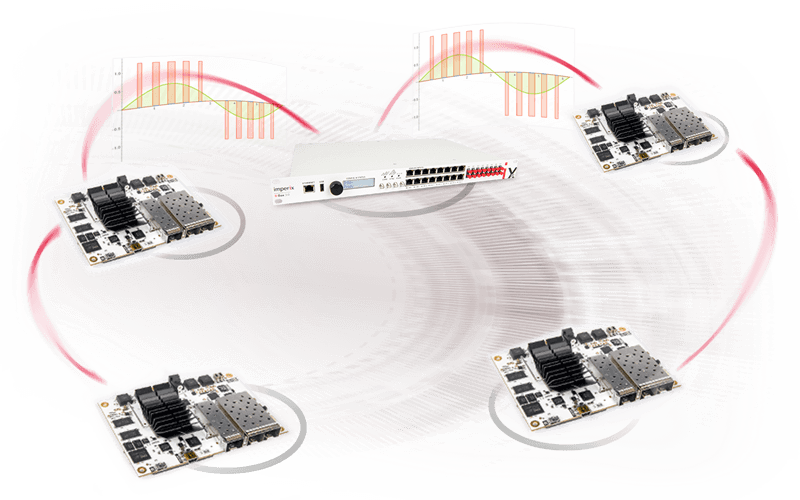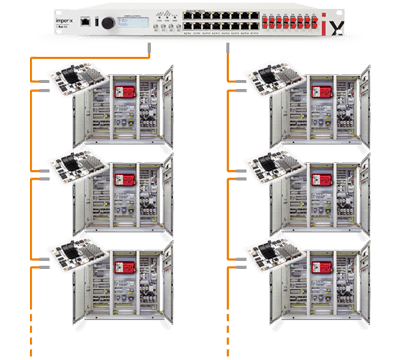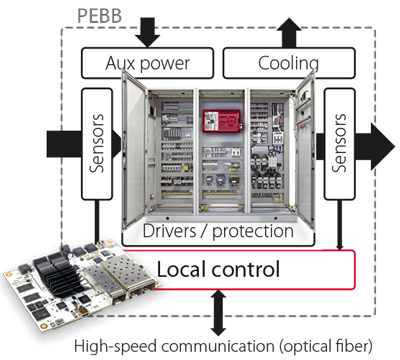
DISTRIBUTED MODULATION
NETWORKED CONTROL TECHNOLOGY FOR POWER ELECTRONICS
Synchronized PWM signals generation across multiple digital controllers
Thanks to distributed modulation, B-Box 4, B-Box RCP 3.0 and B-Board PRO (incl. TPI8032) support the generation of precisely-synchronized PWM signals across numerous interconnected devices.
Our patented technology guarantees a time resolution of 4ns and an accuracy of ±2ns for any modulation output.
This allows multiple controllers to behave as if all PWM signals were generated from a single centralized modulator.
DISTRIBUTED MODULATION FOR MODULAR POWER CONVERTERS
Power conversion systems are are getting increasingly modularized. This indeed comes with several benefits related the standardization of the power subsystems. Among other benefits, modular power converters notably offer lower hardware manufacturing and maintenance costs. Superior scalability and (re)configurability are also important criteria.
On the other hand, the modularization of the power converters also tends to increase the number of power semiconductors inside the overall system. Besides, having several identical power subsystems naturally calls for implementing the same approach on the control stage too! Modular control systems have the same potential for standardization-related benefits.
However, the modularization of the control stage also raises several challenges related to the proper management of data and timings. Notably, subcontrollers must be precisely coordinated with respect to pulse-width-modulated (PWM) signals generation.
The imperix RealSync technology brings a global solution to this challenge, by simultaneously guaranteeing a perfect synchronization between devices as well a very low-latency data transfers. Furthermore, our distributed modulation technology supports the same performance and accuracy as the centralized equivalent solution, with a modular hardware approach that is suitable to modern power converters.

Coordinated control of power inverters
A distributed modulation strategy is essential when several power inverters must be coordinated, for instance for the sake of interleaving their PWM carrier waveforms.

Modular design of power converters
Modular power converters are based on numerous power electronic building blocks (PEBBs). Modular hardware with distributed modulation is well suited for the control stage.

Control of complex multilevel converters
Complex converter topologies involve a high number of measurements and PWM signals. Distributed modulation is an elegant solution for simplify the mechanical design.
THE CHALLENGES OF DISTRIBUTED MODULATION
MAKING THE CONTROL NETWORK INVISIBLE

A TECHNOLOGICAL CHALLENGE WITH TWO PARTS
Distributed modulation is only equal to conventional modulation provided that the de-centralization is absolutely transparent, both in terms of use and performance. This means that the control network must be absolutely invisible and have no impact on the modulation processe(s).
There are essentially two technical challenges to that:
Ultra-low-latency data transfers between devices
Distributed modulators must receive their parameters (e.g. duty cycle, phase, etc.) with no further delay compared to the centralized approach.
Perfect synchronization of all time-related actions
The distributed modulators must provide the same time resolution and accuracy as modulators belonging to a unique hardware (e.g. DSP or FPGA).
HIGHLY-ACCURATE SYNCHRONIZATION
BENEFITS OF DISTRIBUTED MODULATION
PWM phase-shifts can be mastered accurately
Thanks to network-wide synchronization, the phase-shift between any PWM channels of any physical device can be precisely mastered and adjusted freely. This is notably useful for:
- Interleaved power converters
- Dual-active bridge and similar converters
- Parallel-operated inverters
Coherent PWM signals are generated across the network
The time accuracy of the distributed modular is such that complementary PWM signals can be taken out of any unit!
For instance, the high-side and low-side signal can even be generated by different devices, with the same precision on dead-time as if the PWM signals were generated in a centralized fashion.
Series- and paralled-connected switches can be operated
What’s more, with our distributed modulation technology, the time resolution and accuracy are so high that series-connected or parallel-connected semiconductors can directly be operated, across the network!
Indeed, our patented solution guarantees a time resolution of 4ns and an accuracy of ±2ns for any modulation output. This is strictly the same performance level as centralized modulation.
DISTRIBUTED MODULATION TECHNOLOGY
CLOCK DISSEMINATION ACROSS THE NETWORK
Distribution of a synthonized clock over SFP+
Regarding synchronization, the RealSync technology is based on the distribution of a common high-frequency clock across the entire control network. Thanks to this approach, all distributed modulators are truly brought inside the same clock domain, not simply continuously (re)synchronized.
No continuous synchronization needed
Since all modulators belong to the same clock domain, there cannot be any drift between them. Therefore, continuous re-synchronization is dispensable.
In fact, it would even be counter-productive as it would produce useless data traffic and undesirable jitter.
Highly-accurate stabilized clock sources
Imperix controllers are not only always well synchronized, they also benefit from very clean and stable oscillators.
This excellent clock source guarantees very reliable operation across the most stringent conditions, including large temperature variations as well as over time.
A perfect reference for all processes
Clock dissemination across benefits to all kinds of pulse-width modulation (PWM) techniques. Indeed, all standard modulators proposed by our controller are naturally synchronized.
Furthermore, the ADC sampling instants are also directly managed from a synchronized clock.
Imperix RealSync technology
The RealSync technology covers the clock dissemination and distributed modulation techniques, which are protected by several patents. The technology also addresses low-latency data transfers, which are essential to networked control systems for power electronics.
PERFORMANCE BENCHMARK
PWM SYNCHRONIZATION ACCURACY
The total synchronization mismatch between PWM signals is an extremely important parameter, notably as it constraints the minimum dead-time between complementary – high and low – PWM signals.
In the B-Box 4 and B-Box RCP 3.0, special attention was paid to minimize any unbalance also at the hardware level, up to the electrical and optical fiber outputs.
| PWM specification | Same device | Between devices |
|---|---|---|
| Propagation delay asymetry, electrical PWM | ± 3.8ns | ± 5.8ns |
| Propagation delay asymetry, optical PWM | ± 13ns | ± 15ns |
Eventually, the minimum dead-time also requires to account for other sources of propagation unbalances, after the modulators themselves, such as within the gate drivers and other similar circuits. This topic is addressed by a dedicated article on the imperix knowledge base.
PWM synchronization accuracy for N=6 devices
Histogramms of the synchronization error between multiple devices hosting distributed modulators. The maximum error is bounded to ±2ns.
DISTRIBUTED MODULATION WITHIN LARGE SYSTEMS
VIRTUALLY BOUNDLESS SCALABILITY
The right modulation technology for complex power inverters
Thanks to distributed modulation, imperix digital controllers can support a large number of synchronized PWM channels. This typically ranges up to one thousand of time-coherent outputs.
 |  | |
| Component | Single (1 device) | Stacked (64 devices) |
|---|---|---|
| Analog inputs | 16x | 1024x |
| PWM outputs Optical | 16x | 1024x |
| PWM outputs Electrical | 32x | 2048x |
| General-Purpose digital Outputs (GPO) | 16x | 1024x |
| General-Purpose digital Inputs (GPI) | 16x | 1024x |
ERROR MANAGEMENT
FAULT DISSEMINATION STRATEGY
Critical faults disseminate in all directions simultaneously
The distribution of pulse-width modulators (PWM) across the control network doesn’t prevent the effective blocking of PWM signals generation in case of error. The imperix RealSync technology implements ultra-fast broadcast fault messages so that all modulators can be instantly blocked.
- Uses highest priority message (not affected by normal traffic)
- 100% software-independent
- Propagated in all directions
- Typical delay ≈ max. radius (# of hops) · 180ns
